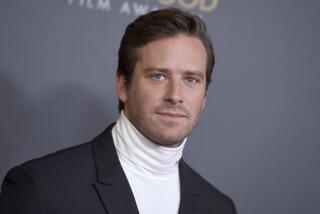Hammer divided yet strong
A secret six-year imbroglio that threatened to dismantle the Hammer Museum -- established by oil baron Armand Hammer and endowed with art by his foundation -- has ended with the museum and the Armand Hammer Foundation agreeing to part company and divide a $305-million collection amassed by Hammer.
Under terms approved by the University of California Board of Regents, which has managed the museum since 1994, the foundation will cede its role in the museum’s governance and relinquish many contentious restrictions, including a “reversionary clause” that gave it the right to reclaim the collection and some endowment funds.
In return, the foundation will walk away with 92 paintings valued at $55 million.
The museum -- which has developed a renowned contemporary art exhibition program in recent years -- will retain by far the most valuable portion of the collection, 103 works valued at $250 million. Highlights include the museum’s trademark paintings by Rembrandt, Vincent van Gogh and John Singer Sargent. In addition, the museum will keep 7,500 works by 19th century French satirist Honore Daumier and his contemporaries valued at $8 million.
The settlement is a result of issues raised by Michael A. Hammer, grandson of the late Armand Hammer and director of the foundation. “I am satisfied that we have come to a successful resolution where both sides are happy,” Hammer said Thursday.
Ann Philbin, director of the museum, also expressed approval: “We may now move forward unfettered by an extremely threatening reversionary clause. We will have more freedom to define our activities by the standards and practices of the field.”
Reviewing the institution’s evolution, Hammer said that “when the museum was established, documents were put together that were very restrictive. As times have changed and the museum’s direction has changed under the guidance of Annie Philbin, who has done a wonderful job, these things needed to be revisited and reworked. We were able to accomplish what we needed to do, which was to redo the documents and allow the museum to continue to grow.
“It was important to my grandfather to have a museum. There will be a designated wing in the museum that will house only his pictures. That’s why I have agreed to let the best pictures stay there, knowing they will be on public display.”
Sixteen of the 92 works returned to the foundation are required to be lent to museums in the United States, but he said that all the art will be made available for public viewing.
Former Sen. John V. Tunney, chairman of the museum’s board of trustees, praised the agreement in a statement, calling it “a major milestone in the Hammer Museum’s young history” that will open “a great new chapter by securing the institution and its core collection in perpetuity.”
The agreement, now approved by all the museum’s governing bodies and the attorneys general of California and Delaware, is expected to be signed next week.
In 2001, Michael Hammer raised questions about changes to the museum’s original name, the Armand Hammer Museum of Art and Cultural Center, and the museum’s failure to conform to requirements for displaying the art. Such irregularities were in breach of the founding agreement, making the museum vulnerable to the reversionary clause.
Philbin, who became director of the museum in 1999, said that terms of the founding agreement had never been followed to the letter. The museum staff corrected some of the breaches, she said. But Hammer’s concerns set off years of behind-the-scenes discussion, reassessment, negotiation and mediation.
“The biggest challenge,” she said, “was finding the formula for a resolution of the conflict. Getting to a place where we could accept the notion of returning works from the collection in exchange for securing the health and well being of the institution was a long process.”
The original agreement obliged the museum to display 140 works from the collection at all times, with Daumiers exhibited in an additional gallery. Under the new arrangement, the minimum number of works has dropped to 35 and the Daumiers can fulfill that requirement.
“You will see a much more refined hanging of the work in the Armand Hammer Collection galleries,” Philbin said. “The terms of the new agreement allow us to devote only one of our main galleries to the Armand Hammer Collection. We gain a gallery to feature our other collections and our new and growing Hammer Contemporary Collection.”
The collection assembled by the museum’s founder encompasses paintings, drawings and prints from the 16th through the 20th centuries by European and American artists -- some prominent, some obscure -- and the quality varies greatly. For advice about how to divide the works, the museum turned to John Walsh, director emeritus of the J. Paul Getty Museum and adjunct professor of art history at Yale University. Working with Cynthia Burlingham, the Hammer’s deputy director of collections, he considered all 195 works in terms of artistic and historical significance and in context of the artists’ work.
The goal, he said, was to refine the collection in a way that would not diminish its quality or importance. Works that will go to the foundation include paintings by French Impressionists Edgar Degas, Pierre Auguste Renoir and Camille Pissarro, works by American artists Mary Cassatt and William Michael Harnett, and a Russian-made tapestry depicting America.
What’s left at the museum is “a smaller but stronger collection,” Walsh said. “The Hammer will be a better museum. It won’t be burdened by having to show a lot of substandard paintings. It won’t be threatened by extinction if it doesn’t. It will show the best of Armand Hammer’s collection, works that really are of museum quality. And it will be free to go on doing what it has been doing brilliantly, free from this death penalty.”
The agreement is but the latest upset at an institution born amid controversy. Hammer founded the museum in 1989 after reneging on a longtime promise to donate his collection to the Los Angeles County Museum of Art. As his museum rose adjacent to Occidental Petroleum’s headquarters, his corporate fiefdom at the corner of Westwood and Wilshire boulevards, news that the company was footing the bill and that it also had paid for many of Hammer’s artworks set off a shareholders’ protest.
Hammer opened his museum in December 1990 but died 10 days later. The fledgling institution, governed by the foundation and Occidental, was adrift until March 1994, when it entered into a 99-year operating agreement with the UC Regents. Since then, the university has been in charge of management and programs.
Despite all the bumps along the way, the museum’s future seems to be secure. In 2021, it plans to use proceeds of a bond portfolio to purchase the building that houses the museum and Occidental’s headquarters.
More to Read
The biggest entertainment stories
Get our big stories about Hollywood, film, television, music, arts, culture and more right in your inbox as soon as they publish.
You may occasionally receive promotional content from the Los Angeles Times.










